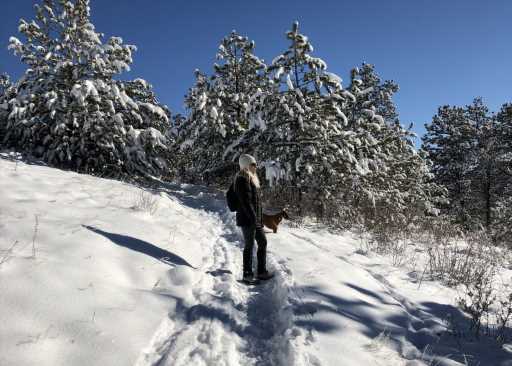Winter hiking and snowshoe trails in Colorado from 1-6 miles
With snow on the ground throughout Colorado and ski season in full swing, winter hiking might seem like an odd choice of activity, or at least out of season. There are a lot of benefits to hiking or snowshoeing in the winter: fewer people on the trails for starters, along with hibernating bugs and wildlife so you don’t have to contend with them, and the benefits of intense exercise.
We’ve got some suggestions on where to go (below), but first, here are some of the similarities and some of the differences between winter hiking and snowshoeing.
For ideal snowshoeing, look for deep snow that’s not icy on top. You don’t want to sink into that snow, but you also don’t want to end up scraping mud and rocks with the bottoms of your snowshoes. Snowshoeing in fresh powder can be a blast, but it’s also quite a workout. One challenge I often find with snowshoeing in Colorado is a mix of conditions on a single trail. I often start out snowshoeing and then end up carrying my ‘shoes for a while because there isn’t enough snow in spots, or the trail gets too narrow or steep to navigate.
For ideal winter hiking, you want to avoid trails that are getting a lot of sun as they might get icy or muddy. With the proper gear, such as microspikes attached to your boots, a trail that holds snow is best. Hiking basics like water, sunglasses, sunscreen, and a safety plan are still essentials in winter, along with the warmer layers you’ll be wearing. Hiking poles can be helpful when hiking in winter to test the depth of snow and to help you tackle inclines.
Snowshoeing and winter hiking require basic avalanche safety awareness, such as recognizing and evaluating the pitch of surrounding mountains. Consider taking a class in avalanche preparedness and safety, and check with the land management agency such as the National Park Service, Colorado State Parks, local county open space, or the U.S. Forest Service to get the latest avalanche conditions in your trail area. The Colorado Avalanche Information Center can also provide details on places of high risk.
Consider these trails for your next winter hiking or snowshoeing adventure
Red Rock Lake in the Brainard Lake Recreation Area
- Distance: 1 mile
- Type: Out-and-back
In the winter, the road into the Brainard Lake Recreation Area trailheads is closed. The closed road can be hiked, walked, snowshoed, and even skied on, depending on conditions. It is 2 miles from the lower, or winter, parking lot to Brainard Lake, and then another mile or so to the parking lots for Mitchell Lake and Lake Isabelle.
You can choose to hike to these further destinations, or keep it simple and take the Colorado Mountain Club trail to the left of the guard station and head west. You might be sharing the trail with skiers and snowshoers. Pretty quickly you reach Red Rock Lake, which in the summer is nearly filled with lily pads. There is always the option of coming back on the road if the snow is too deep and challenging.
Dogs are allowed only on the Brainard Lake and Left Hand Park Reservoir roads in winter. Fees are not required in winter.
Mountain Lion Trail in Golden Gate Canyon State Park
- Distance: 6.7 miles
- Type: Loop
While considered difficult, thanks to the undulating hills (another way of saying this hike is really steep in spots!), this trail does have some relatively flat stretches. A thick forest of evergreen trees makes this trail particularly pretty after a fresh snowfall.
Dogs are permitted on all trails in the park, but must be on a 6-foot leash at all times. Enjoy the views!
Catch the trail at the Nott Creek trailhead off Crawford Gulch Road. For a shorter hike (just over a mile), there’s a logical turnaround when Mountain Lion intersects with the Burro Trail at the service road.
Lost Lake via Hessie Trail
- Distance: 4 miles
- Type: Out-and-back
There might be an additional half mile or so to this trail, depending on where you can park in the winter as the dirt road on the edge of Eldora does close at some point, and this area can be popular with hikers. You’ll have some creek crossings and a waterfall en route to the turnoff for Lost Lake.
For the most part, the trail is wide and flanked by trees. The last half-mile up to the lake is narrower and tree-covered so likely to be pretty snowy. I’ve done this hike in fresh powder and had the place to myself! Leashed dogs are welcome.
Historic Cabin Trail at Staunton State Park
- Distance: 2 miles
- Type: Balloon
By taking two trails, you can do both an out-and-back and a loop here. Starting at the main parking lot, take the Staunton Ranch trail for about 1 mile, then go left at the Historic Cabin trail. Interpretative signs will teach you about the history of this park — some parts were formerly ranchland — and the preserved buildings. This trail will loop back to the Staunton Ranch trail in less than a mile, and you will head back the way you came.
Dogs are allowed and must be kept on a 6-foot leash at all times.
Discovery & Challenger Trails at Bonfils-Stanton Foundation Outdoor Center in Winter Park
- Distance: 1.5 miles
- Type: Loop
Right across from the entrance to Winter Park Resort you’ll find a parking area for trailheads within the Bonfils-Stanton Foundation Outdoor Center boundaries. Hidden under the snow is a wooden boardwalk which makes this a handicap-accessible trail in summer and keeps the trail from getting too muddy in winter.
This is a drainage area so it’s recommended that you stay on the trail to avoid marshy spots. Tall pine trees filter out sunlight and noise, giving the fallen snow that exquisite hush as you hike.
Zook and Blackmer Trails at Cheyenne Mountain State Park in Colorado Springs
- Distance: 4.5 miles
- Type: Loop
This moderate trail that leads you from prairie grasses and scrub oaks to a rock garden and then into the ponderosa pine forest. It’s on the eastern flank of Cheyenne Mountain, which often means icy or muddy conditions will dry out here long before they will on other area trails. Start on the Zook Loop near the main parking area and catch the Medicine Wheel Spur to the Blackmer Loop. You can add nearly a mile by taking Cougar’s Shadow at the “top” of the hike.
Dogs aren’t allowed on this trail, but are welcome on a group of looping trails near the campgrounds. Wild turkeys and deer abound here and there’s a prairie dog colony off the adjacent Sundance Trail.
Before you set out, remember that the shorter days of winter mean you have less time to hike so start as early as you can. One of the highlights of a winter hike can be seeing a familiar spot covered in fresh, white snow as it changes the landscape seasonally.
Subscribe to our weekly newsletter, The Adventurist, to get outdoors news sent straight to your inbox.
Source: Read Full Article






